Mammals of the Adirondacks:
Eastern Chipmunk (Tamias striatus)
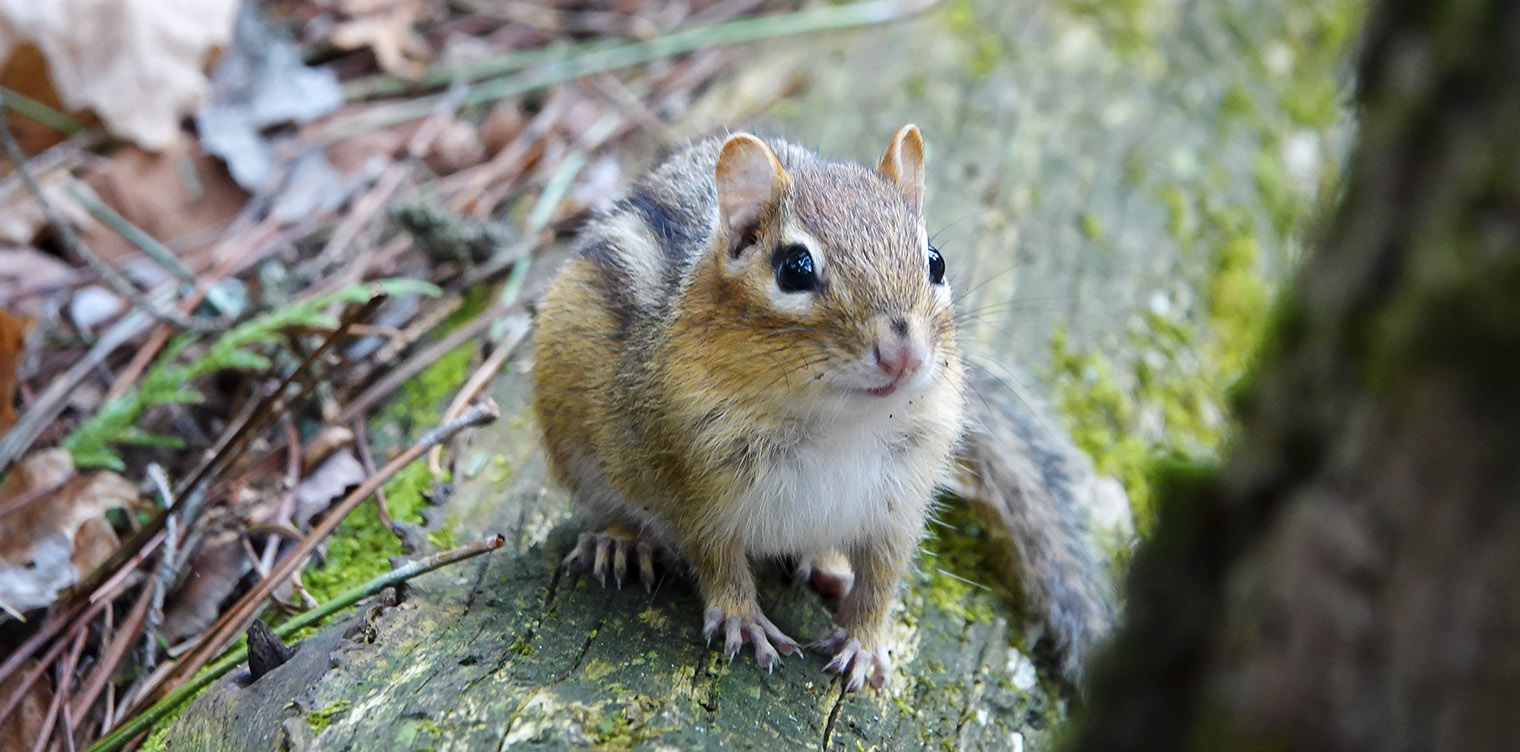
The Eastern Chipmunk (Tamias striatus) is a small, striped rodent found in mature hardwood and mixed wood forests in the Adirondack Mountains of upstate New York.
Eastern Chipmunks (like American Beaver and North American Porcupine) are assigned to the rodent (Rodentia) order, the single largest group of mammals. The Eastern Chipmunk is a member of the squirrel family (Sciuridae). Other members of this family who make their home in the Adirondacks include Woodchucks, Gray Squirrels, Red Squirrels, Northern Flying Squirrels, and Southern Flying Squirrels.
The name "chipmunk," said to be of native American origin, apparently derives from the chipping call these mammals make.
- The genus name (Tamias) is from the Latin word meaning "collector" or "storer" – a reference to the Eastern Chipmunk's winter survival strategy of storing food in its burrow.
- The species name (striatus) means "striped" – a reference to the prominent black and white stripes on the Eastern Chipmunk's body.
- Other nonscientific names for the Eastern Chipmunk include Ground Squirrel, Striped Squirrel, and Chipping Squirrel.
There are eleven subspecies of Tamias striatus. The one that lives in our region is Tamias striatus lysteri.
Eastern Chipmunk: Description
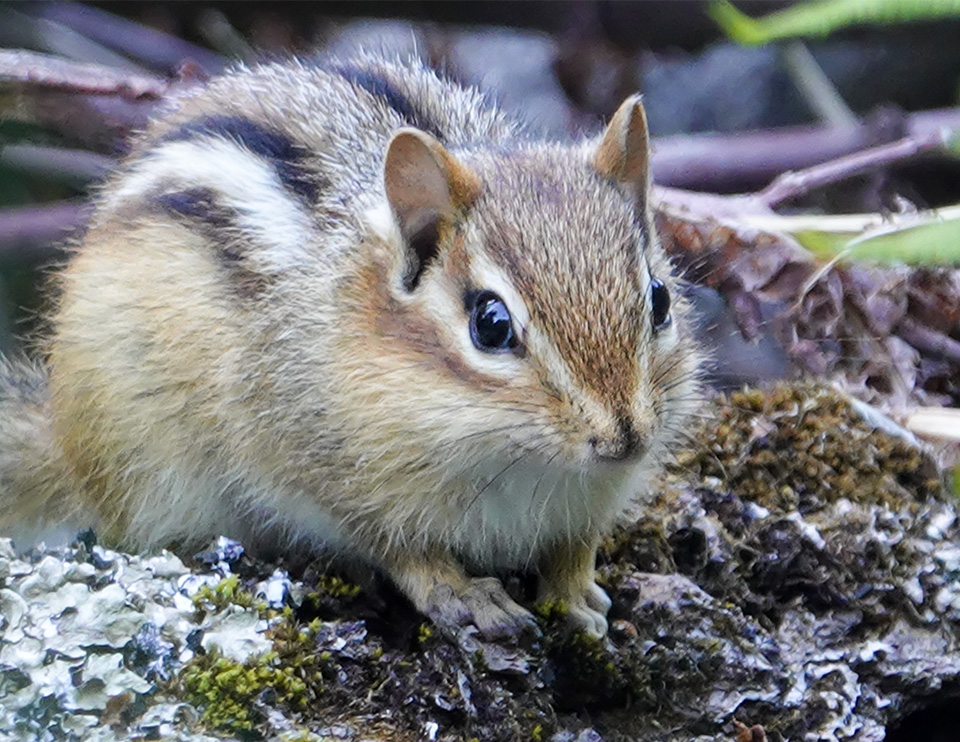
Eastern Chipmunks are small, rather chunky rodents with prominent longitudinal stripes on their bodies. Eastern Chipmunks average 9.6 inches in length (including the tail), weighing in at about 3 ounces. They are significantly smaller than the two other members of the Sciuridae family most commonly seen in the Adirondacks: Red Squirrels (which average 12 inches in length) and Gray Squirrels (which average 18-20 inches in length).
The Eastern Chipmunk has five nearly black stripes on its back and sides. It has a narrow, dark stripe that extends from the back of the head toward the rump. This is bordered on each side by wider stripes of gray to reddish-organge. On each side are two narrow, dark stripes enclosing a wider stripe of white or yellowish white. Below the stripes, the Eastern Chipmunk's sides are yellow-orange, grading into a buffy white on its underparts.
The tail, which is about 3.7 inches long, is dark above with a light gray border; the underside has a central stripe bordered by narrower dark stripes. The Eastern Chipmunk's tail is moderately furred, but not bushy like that of the Gray Squirrel.
Eastern Chipmunks have prominent eyes, bordered above and below by two short whitish stripes. The cheeks and crown are a grizzled gray. The chin and throat are white. Eastern Chipmunks have large cheek pouches on each side of their mouths and fairly prominent, rounded ears.
Eastern Chipmunks are quite similar in appearance to Least Chipmunks (Tamias minimus), which also have distinctive stripes. Least Chipmunks, however, are significantly smaller than our Eastern Chipmunks. In any event, Least Chipmunks are found in the western US and Canada, so if you see a small, striped rodent in the Adirondacks you can be confident that it's an Eastern Chipmunk.
Eastern Chipmunk: Diet
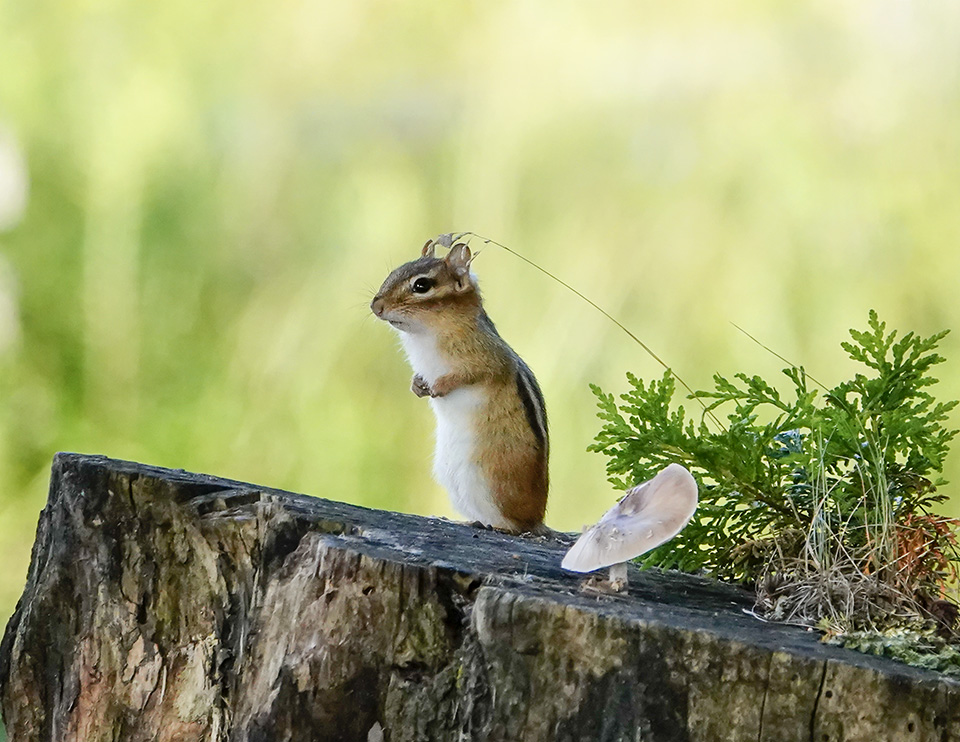
The Eastern Chipmunk's menu is dominated by nuts, seeds, tubers, and fruits.
- A study of feeding behavior of Eastern Chipmunks in the Adirondacks found that nuts from American Beech are a mainstay, as are seeds from Sugar Maple and Red Maple and tubers from Trout Lily.
- Less important food items include seeds from Yellow Birch, Striped Maple, and Black Cherry.
Most of these items are cached underground for consumption during the cold winter months, but some are scatter-hoarded in the spring and early summer for consumption later in the season. Fungi (both aboveground and belowground) and fruit (especially blackberries) are also eaten, as are American Beech and Sugar Maple seedlings, Sugar Maple flowers, the flowers of Painted Trilliums and Purple Trilliums, and sunflower seeds.
Eastern Chipmunks are omnivores; they supplement their diets with small mammals, turtles (such as Painted Turtles) amphibians, snakes, slugs, worms, frogs' eggs, beetles, dragon flies, and other insects. The Eastern Chipmunk also preys on a variety of birds and is considered to be a major predator of young ground nesting birds. Eastern Chipmunks are known to plunder the nests (consuming the eggs and nestlings) of the following species: Mourning Warbler, Red-eyed Vireo, Ovenbird, Bicknell's Thrush, Eastern Phoebe, Least Flycatcher, American Robin, Eastern Towhee, House Finch, Northern Cardinal, Eastern Bluebird, American Redstart, White-throated Sparrow, Black-throated Blue Warbler, and Field Sparrow.
The relative contribution of plant and animal foods for Eastern Chipmunks in the Adirondacks is not known. However, a study of Eastern Chipmunk diets in Indiana found that over 60% of the volume of food was mast (unidentified nut material), 13% insects, 8.3% fruit, 6.4% seeds, and 4.3% vertebrates, suggesting that less than a fifth of the Eastern Chipmunk's menu is nonplant material.
Eastern Chipmunk: Reproduction and Family Life
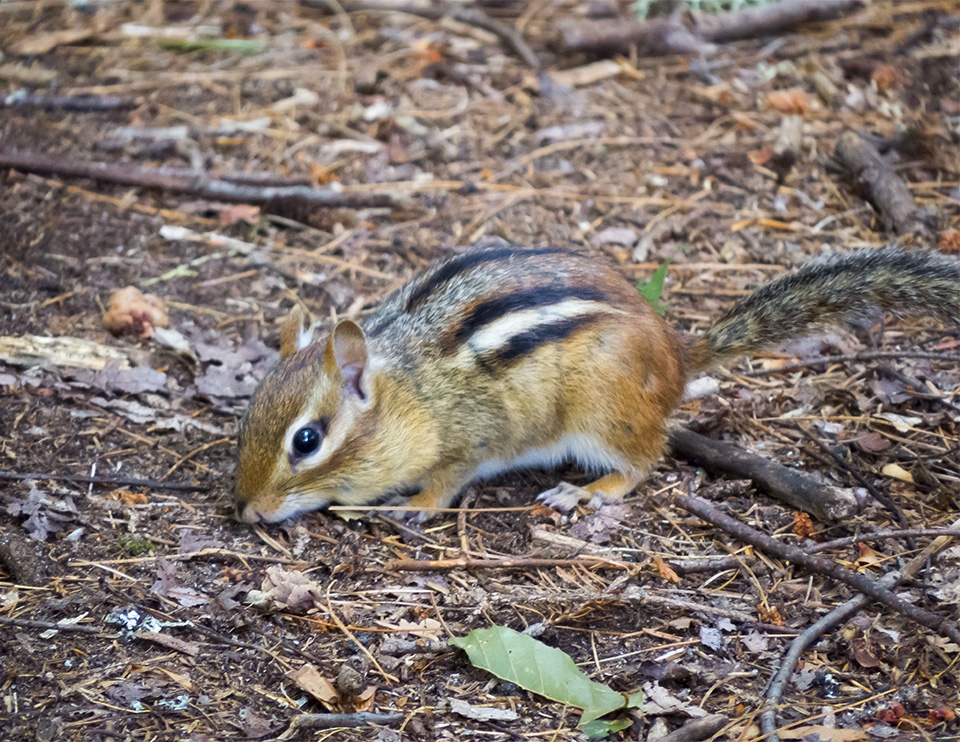
Eastern Chipmunks reportedly have two breeding seasons. Sources conflict on the timing, with some indicating a spring mating season between late February and early April and a summer mating season between June and August and others suggesting March to April as the spring season and June to July as the summer season. A study of the Eastern Chipmunk in the Adirondack Mountains suggests a spring mating season between February and April, with litters emerging above ground in late spring (April to June), and a summer mating season from June to August, with litters emerging above ground in early fall (August to October).
The female is receptive only for a short time, during which she will mate with one or more males. There is no pair bonding between males and females. Soon after mating, the female chases the male away. Male Eastern Chipmunks play no role in the care of young; females provide all parental care.
Pregnancy lasts for 30 to 31 days, during which the female will prepare a nest chamber in her burrow. The young (usually three to five in a litter) are born and nursed below ground in the female's burrow. The young chipmunks are blind and naked at birth. Their eyes open at about 30 days.
At about 40 days, the young (by then fully furred and about 2/3 adult size) start venturing outside the burrow. Litter mates socialize with each other in the first week after emergence. About a week or two after emerging from the natal burrow, the mother refuses the young further entry, and they disperse to find their own territory, assuming the solitary lifestyle of adult chipmunks. Male Eastern Chipmunks disperse farther than females.
Eastern Chipmunk: Behavior
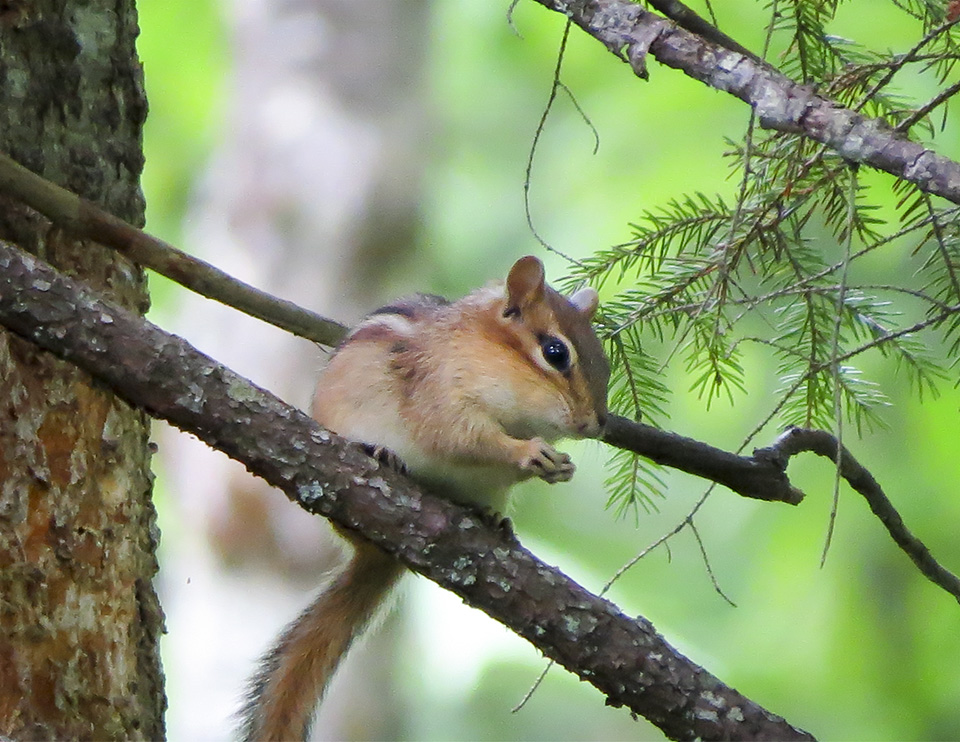
Burrows:
The Eastern Chipmunk's existence is centered around its burrow – a complex maze of interconnecting tunnels about two inches in diameter and 12 to 30 feet long. The burrow consists of several chambers, some to store the chipmunk's cache of food and another six to ten inches in diameter for a nest of leaves. The main entrance of the burrow is a hole about two inches in diameter. The entrance hole does not have any excavated dirt surrounding it. The animal distributes the soil to the surrounding areas.The burrow is at the center of the Eastern Chipmunk's roughly circular home range, which ranges from ½ to one acre. The burrow provides protection from bad weather, security from predators, a place to birth and raise young, and a storage area for the chipmunk's cache of nuts. Most Eastern Chipmunks in the Adirondack region reportedly maintain the same burrow system from season to season and rarely travel more than 45 meters from their burrow.
Activity Patterns:
Eastern Chipmunks are diurnal. They spend the night asleep in their burrow and are up at dawn to spend most of the day foraging and food storing, with peaks of activity in mid-morning and again in mid-afternoon. They pack their nuts and seeds into large food pouches to transport back to the burrow. Early fall (from mid-September to late October) is the busiest season for Eastern Chipmunks, as they scurry around gathering nuts and seeds for their food storage chambers.Most sources note a period of relative inactivity for chipmunks in late summer. In the Adirondacks, this occurs from late July until early September. There are several alternate explanations for this pattern (not necessarily mutually exclusive).
- One possibility is that this is a period of low availability of food in the Adirondack region; the chipmunk can rely on underground food stores during this time and does not need to search for food above ground.
- Another explanation is that the Eastern Chipmunk is attempting to avoid botfly infestation.
- A third possibility is that the chipmunk is trying to keep to his cool underground home during periods of hot weather.
Most of the chipmunk's foraging is done on the ground, with the animal stopping periodically to listen and watch for predators. Although Eastern Chipmunks are competent climbers, they are less at home in the tree tops than the acrobatic Red Squirrel. If frightened by a predator, most chipmunks make a run for their burrow, rather than climb a tree as a Red Squirrel would.
Hibernation:
The Eastern Chipmunk's strategy for dealing with the frigid Adirondack winters is a form of hibernation. In contrast to Woodchucks, true hibernators who store body fat prior to winter, Eastern Chipmunks accumulate little body fat, but spend the early fall before temperatures plunge frenetically searching for and hoarding food, which is stored in the food chambers of its burrow.Eastern Chipmunks retire to their burrows later in the fall (usually in late October or early November in the Adirondack region). They spend most of the winter there, going into a state of torpor for several days at a time, arising periodically to feed and eliminate. These periods of torpor, which are characterized by low metabolic rates, rarely extend beyond three or four days. On mild winter days, the chipmunk may make brief appearances to forage.
The Eastern Chipmunk ends its winter period of inactivity with the coming of the warmer days of spring. In the Adirondack region, the chipmunk's post-winter emergence from the burrow usually occurs in April or May, depending on local snow depth and temperatures.
Social System and Vocalization:
Eastern Chipmunks, except for the very brief mating period and the longer time before the litter disperses in the fall, are solitary in the sense that they do not form colonies like American Beavers, matriarchal groups like White-tailed Deer, or family groups like Eastern Coyotes. This does not mean, however, that Eastern Chipmunks have no contact with other chipmunks. In fact, because home ranges overlap, there can be a significant amount of interaction.During these interactions, Eastern Chipmunks make use of an extensive repertoire of vocalizations, including loud chips, chip-trills, and softer cuk-cuk-cuk calls.
- The most common vocalization for Adirondack chipmunk is said to be the chuck, often prompted by predators flying overhead. A continuous series of chucks suggests that the animal has spotted a predator.
- Another common vocalization is a loud, high-pitched chip – the sound that gives the Eastern Chipmunk its name. It is sometimes continued for several minutes without ceasing.
- Another sound often heard is a combination of a loud chip ending in a trill, often uttered when the chipmunk is darting toward shelter from a possible predator or when the animal is involved in an aggressive encounter with another chipmunk. Trill calls given by females may function to warn other chipmunks in neighboring territories.
Eastern Chipmunk: Mortality and Predators
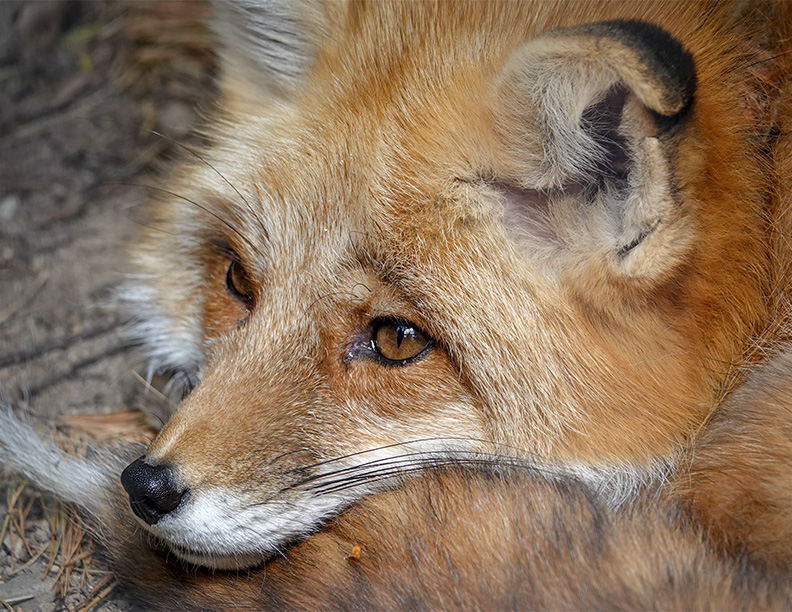
Rodents, including Eastern Chipmunks, are very important as prey species.
Mammals that prey on the Eastern Chipmunk include Red Foxes, Gray Foxes, Bobcats, American Martens, Ermines, Fishers, Long-tailed Weasels, Raccoons, and Eastern Coyotes. Eastern Chipmunks who live near residential areas are also taken by domestic dogs and cats.
Birds known to prey on Eastern Chipmunks include Red-shouldered Hawks, Broad-winged Hawks, Red-tailed Hawks, Barred Owl, Long-eared Owls, Great Horned Owls, and Great Gray Owls.
The Eastern Chipmunk's vulnerability to predation results in a fairly limited life span. Eastern Chipmunks reportedly can live up to eight years, but their life span in the wild is probably closer to a year.
Eastern Chipmunk: Distribution
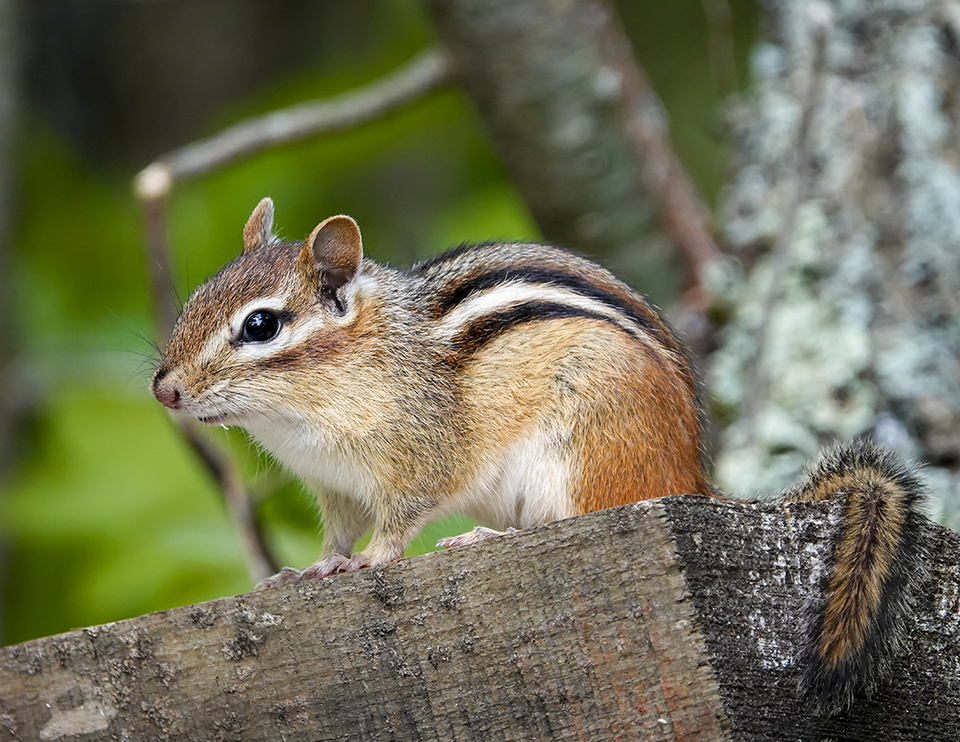
The range of the Eastern Chipmunk covers most of eastern North America, extending from southern Canada south to the Gulf of Mexico. This species extends west essentially to the middle of the US. It is not found in parts of the Southeast, such as the peninsula of Florida and the coastal plans region.
Our subspecies, Tamias striatus lysteri, occurs in the Northeast, including Maine, New Hampshire, Vermont, Massachusetts, the northern parts of Rhode Island and Connecticut, New York State north of Albany, and the northern two-thirds of Pennsylvania.
In the Adirondack Park, the Eastern Chipmunk occurs at elevations up to 4,000 feet. Several studies of small mammal populations in the Adirondacks suggest that Eastern Chipmunks are more abundant than Red Squirrels.
- A 2002 study of small mammals in the central Adirondacks comparing methods of estimating small mammal populations between livetrapping and track tubes found a higher relative abundance of Eastern Chipmunks as compared with Red Squirrels. This finding may have been affected by the habitats chosen for the study sites.
- Another study of small mammal abundance based on small mammal captures between 1992 and 2009 in the Huntington Wild Forest in the central Adirondacks near Newcomb found that Eastern Chipmunks were more abundant than Red Squirrels. Study sites were in forest stands representative of the central Adirondacks (a mosaic of hardwood and mixed deciduous-conifer forests). Interestingly, the researchers found a link between the autumn mast crop for Red Squirrels, but not for Eastern Chipmunks.
- Another study of small mammal abundance using track tubes in locations across the Adirondack Park found a significantly higher abundance of Eastern Chipmunks (as compared with Red Squirrels) across three different types of habitats.
Eastern Chipmunks are also much more abundant than Gray Squirrels, another member of the Sciuridae family native found in the Adirondacks. Gray Squirrels are reliant on oak trees and so are more commonly found in the southern part of the Adirondacks and Lake Champlain Valley.
Eastern Chipmunk Habitat
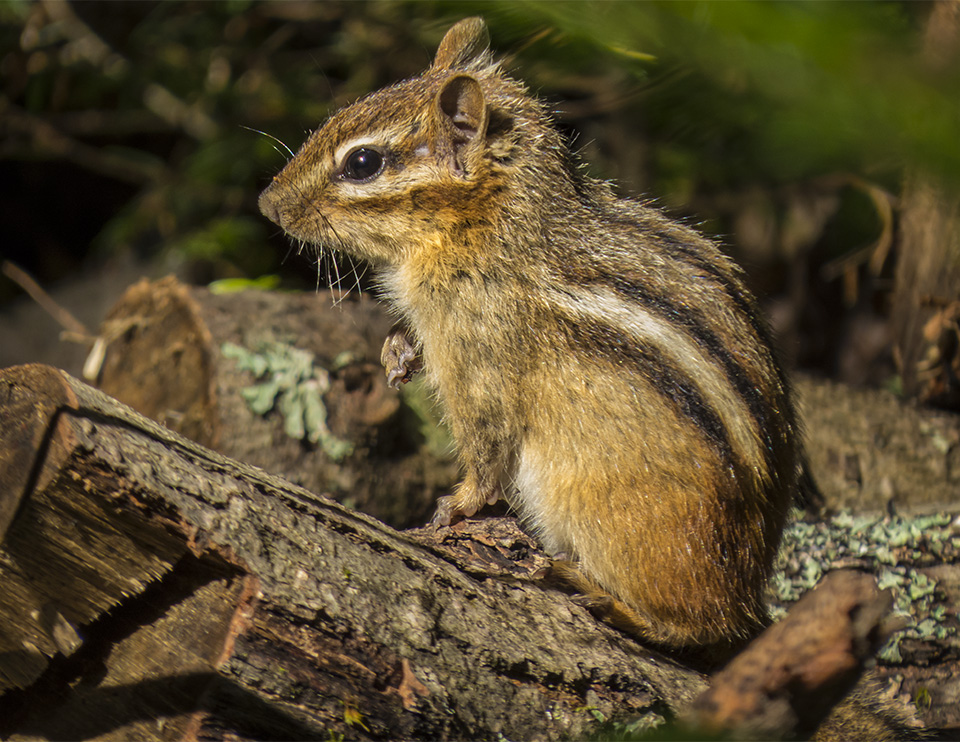
Throughout its range, the Eastern Chipmunk is at home in a variety of habitats. It is found in deciduous and mixed forests, suburban gardens, city parks, river valleys, brushy areas, and coniferous forests. Swampy areas appear to be avoided.
Despite this tolerance for a variety of habitats, the Eastern Chipmunk is most abundant in northern hardwood (deciduous) forests, where cover is readily available in the form of rocks, decaying stumps, and fallen logs. The Eastern Chipmunk's preference for deciduous forests reflects its reliance on nuts from the American Beech and the seeds of Sugar Maple and Red Maple.
Studies of small mammal distribution in the Adirondacks indicate that Eastern Chipmunks show a strong preference for deciduous habitats, as opposed to coniferous sites. Eastern Chipmunks tend to be most abundant in mature forests (sites that have not been logged over the past century), as compared to suburban locations and forests which have been logged more recently. By contrast, the Red Squirrel is found mainly in coniferous and mixed forests.
Where to See Eastern Chipmunks in the Adirondacks
Eastern Chipmunks are quite common in the Adirondacks and can be seen along some portions of all of the trails covered here. Eastern Chipmunks are active during the day and retire to their burrow at night. Intensity of activity may vary, with peaks at mid-morning and mid-afternoon. These rodents reportedly are least active during hot, windy, or rainy weather.
To locate these active little rodents, watch for movement and listen for the high-pitched chip call given as a warning when the chipmunk hears you coming. Most of the Eastern Chipmunk's activity is centered around its burrow. Look for round entrance holes about 2 inches in diameter going directly into the earth with no sign of excavation nearby. Although Eastern Chipmunks can climb trees, they are not as proficient as Red Squirrels and spend most of their time foraging on the ground.
- You are probably most likely to spot a chipmunk in the late spring and early summer and then again in the fall. Late summer and early fall is the chipmunk's busy time, when it appears obsessed with collecting nuts for winter.
- Although numerous sources stress a period of relative chipmunk inactivity from late July to early September, not all of our Adirondack chipmunks seem to have read the email, since there are a fair number of August chipmunk sightings in our region.
- Eastern Chipmunks retire to their burrows when the weather turns cold in October, but warm, sunny days during winter and early spring may bring them out, particularly if they live near bird feeding stations.
Adirondack Mammal List
References
State University of New York. College of Environmental Science and Forestry. Eastern Chipmunk. Retrieved 29 March 2017.
Smithsonian National Museum of Natural History. North American Mammals. Tamias striatus. Retrieved 18 March 2019.
Integrated Taxonomic Information System On-line Database. Tamias striatus. Retrieved 7 March 2019.
F. Cassola. Tamias striatus. The IUCN Red List of Threatened Species 2016: e.T42583A115191543. Retrieved 7 March 2019.
Dana P. Snyder, “Tamias striatus,” Mammalian Species, Number 168 (25 May 1982), pp. 1-8. Retrieved 21 May 2022.
University of Michigan. Animal Diversity Web. Tamias striatus. Eastern Chipmunk. Retrieved 7 March 2019.
D. Andrew Saunders. Adirondack Mammals (Adirondack Wildlife Program. State University of New York. College of Environmental Science and Forestry, 1988), pp. 76-79.
William K. Chapman. Mammals of the Adirondacks. A Field Guide (North Country Books, 1991), pp. 54, 58, Plate 13.
John O. Whitaker, Jr. and William J. Hamilton, Jr. Mammals of the Eastern United States (Cornell University Press, 1998), pp. 198-200, 203-207. Retrieved 21 May 2022.
William J. Hamilton and John O. Whitaker, Jr. Mammals of the Eastern United States. Second Edition (Cornell University Press, 1979), pp. 138-141, 279-281. Retrieved 21 May 2022.
iNaturalist. Adirondack Park Sightings. Eastern Chipunk. Tamias striatus. Retrieved 21 May 2022.
iNaturalist. Eastern Chipunk. Tamias striatus. Retrieved 21 May 2022.
Alexander C. Martin, Herbert S. Zim, and Arnold L. Nelson. American Wildlife & Plants. A Guide to Wildlife Food Habits (Dover Publications, 1951), pp. 222, 253, 255, 287-289, 306-310, 324-331, 339-340, 345-346, 350-351, 362-364, 419. Retrieved 16 February 2019.
James M. Ryan. Adirondack Wildlife. A Field Guide (University of New Hampshire Press, 2008), pp. 193-194.
Donald W. Stokes and Lillian Q. Stokes. A Guide to Animal Tracking and Behavior (Little, Brown and Company, 1986), pp. 178-188.
William Henry Burt. A Field Guide to the Mammals of North America North of Mexico. Third Edition (Houghton Mifflin Company, 1980), pp. 108-109, Plate 11.
National Geographic Society. Wild Animals of North America (National Geographic Society, 1995), p.108. Retrieved 21 May 2022.
Adrian Forsyth. Mammals of North America. Temperate and Arctic Regions (Firefly Books, 2006), pp. 89-90. Retrieved 21 May 2022.
Richard M. DeGraaf and Mariko Yamasaki. New England Wildlife: Habitat, Natural History, and Distribution (University Press of New England, 2001), pp. 323, 347-350, 418, 452. Retrieved 16 February 2019.
Clinton Hart Merriam. The Vertebrates of the Adirondack Region, Northeastern New York (Press of L.S. Poster, 1882), p. 52. Retrieved 2 March 2017.
Clinton Hart Merriam. The Mammals of the Adirondack Region, Northeastern New York (Self-published, 1884), pp. 233-239. Retrieved 2 March 2017.
Richard W. Thorington, Jr., John L. Koprowski, Michael A. Steele, and James F. Whatton. Squirrels of the World (Johns Hopkins University press, 2012), pp. 343-346. Retrieved 21 May 2022.
Elsa G. Allen. The Habits and Life History of the Eastern Chipmunk, Tamias striatus lysteri. New York State Museum Bulletin. No. 314 (September 1938). Retrieved 9 March 2019.
Cornell Lab of Ornithology, Ithaca, New York. Birds of North America. Subscription Web Site. Red-shouldered Hawk, Broad-winged Hawk, Ovenbird, Mourning Warbler, Bicknell's Thrush, Eastern Phoebe, Red-eyed Vireo, Least Flycatcher, Red-tailed Hawk, American Robin, Field Sparrow, Eastern Towhee, House Finch, Northern Cardinal, Eastern Bluebird, American Redstart, White-throated Sparrows, Black-throated Blue Warbler. Retrieved 15 March 2019.
Cornell Lab of Ornithology, Ithaca, New York. All About Birds. Barred Owl, Long-eared Owl, Great Horned Owl, Great Gray Owl. Retrieved 15 March 2019.
Paul G. Jensen, Charlotte L. Demers, Stacy A. Mcnulty, Walter J. Jakubas, and Murray M. Humphries, "Marten and Fisher Responses to Fluctuations in Prey Populations and Mast Crops in the Northern Hardwood Forest," The Journal of Wildlife Management, Volume 76, Number 3 (April 2012), pp. 489-502. Retrieved 7 March 2019.
Robert T. Brooks, Harvey R. Smith, and William M. Healy, "Small-mammal Abundance at Three Elevations on a Mountain in Central Vermont, USA: A Sixteen-year Record," Forest Ecology and Management, 110 (1998), pp. 181-193. Retrieved 7 March 2019.
Gordon L. Kirkland, Jr. and Rebecca J. Griffin, "Microdistribution of Small Mammals at the Coniferous-Deciduous Forest Ecotone in Northern New York," Journal of Mammalogy, Volume 55, Number 2 (May, 1974), pp. 417-427. Retrieved 15 February 2019.
Michale J. Glennon, William F. Porter and Charlotte L. Demers, "An Alternative Field Technique for Estimating Diversity of Small-Mammal Populations," Journal of Mammalogy, Volume 83, Number 3 (August 2002), pp. 734-742. Retrieved 16 March 2019.
Michale J. Glennon and William F. Porter, "Impacts of Land-Use Management on Small Mammals in the Adirondack Park, New York," Northeastern Naturalist, Volume 14, Number 3 (2007), pp. 323-342. Retrieved 14 March 2019
Lang Elliott. Social Behavior and Foraging Ecology of the Eastern Chipmunk (Tamias striatus) in the Adirondack Mountains (Smithsonian Institution Press, 1978). Retrieved 8 February 2019.
John A. Wrazen and Linda A. Wrazen, "Hoarding, Body Mass Dynamics, and Torpor as Components of the Survival Strategy of the Eastern Chipmunk," Journal of Mammalogy, Volume 63, Number 1 (February 1982), pp. 63-72. Retrieved 16 February 2019.
Ralph W. Yerger, "Home Range, Territoriality, and Populations of the Chipmunk in Central New York," Journal of Mammalogy, Volume 34, Number 4 (November 1953), pp. 448-458. Retrieved 15 February 2019.
Robert T. Meyer. Small Mammal Consumption of Hypogeous Fungi in the Central Adirondacks of New York. (2014) Honors Theses. 21. Retrieved 16 March 2019.
Craig Patrick Black. The Ecology and Bioenergetics of the Northern Black-Throated Blue Warbler (Dendroica caerulescens caerulescens)," Ph.D Dissertation, Dartmouth, Hanover, New Hampshire (July 1975). Retrieved 28 January 2020.
Barbara Guerra and William L. Vickery, "How Do Red Squirrels, Tamiasciurus hudsonicus, and Eastern Chipmunks, Tamias striatus, Coexist?" Oikos, Volume 83, Number 1 (Octobr1998), pp. 139-144. Retrieved 15 February 2019.
Ellen Rathbone, "The Eastern Chipmunk in Winter," Adirondack Almanack, 26 December 2009. Retrieved 8 March 2019.
Elise Tillinghast, "Preparing for Winter: Chipmunk Game Theory 101," Adirondack Almanack, 2 November 2013. Retrieved 8 March 2019.
Corrina Parnapy, "Chipmunks: Friendly Harbingers of Spring," Adirondack Almanack, 11 April 2015. Retrieved 8 March 2019.
